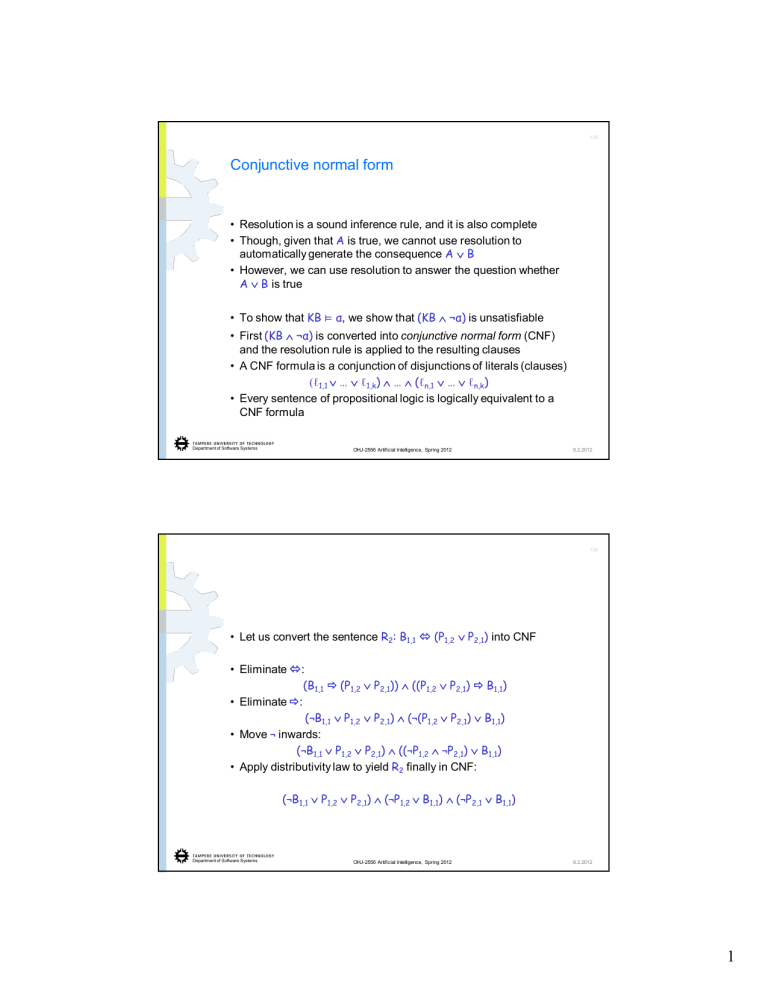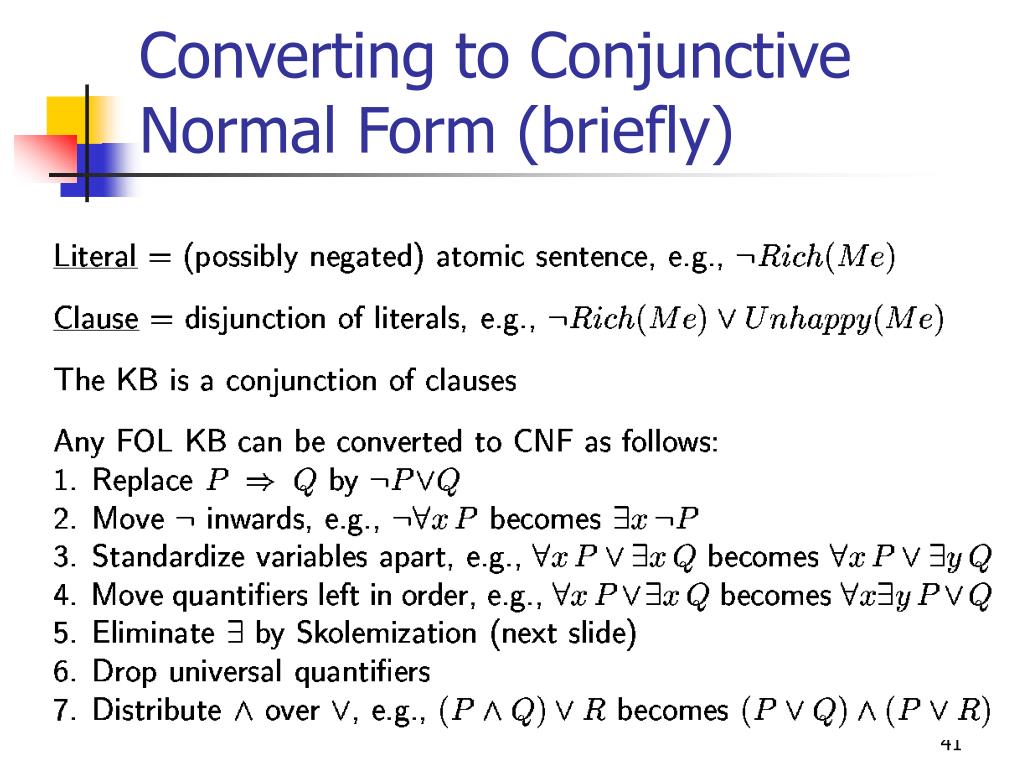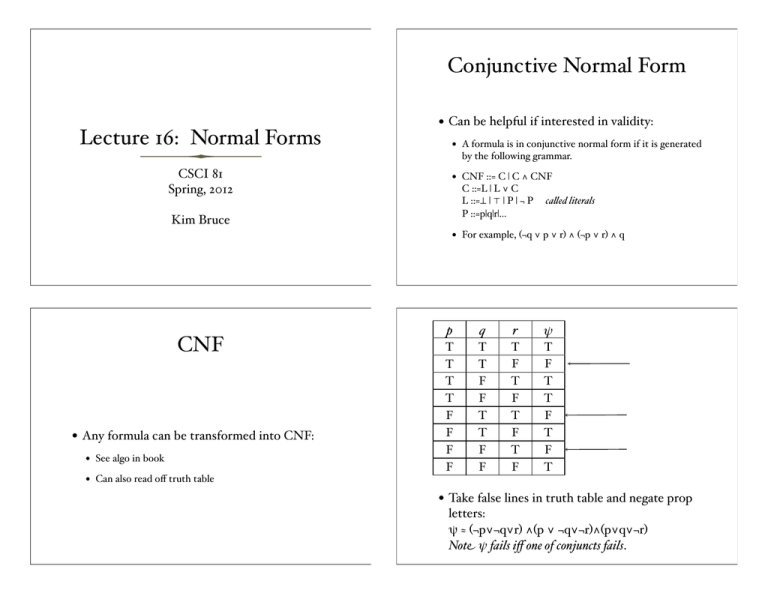Converting To Conjunctive Normal Form
Converting To Conjunctive Normal Form - Just type it in below and press the convert button: The disjunctive normal form can be found by covering the $1$ entries with rectangles that correspond to conjunctions. Push negations into the formula, repeatedly. To convert to conjunctive normal form we use the following rules: $p\leftrightarrow \lnot(\lnot p)$ de morgan's. I am trying to convert the following expression to cnf (conjunctive normal form): $$ (a \wedge b \wedge m) \vee ( \neg f \wedge. To convert a propositional formula to conjunctive normal form, perform the following two steps: This page will convert your propositional logic formula to conjunctive normal form.
To convert a propositional formula to conjunctive normal form, perform the following two steps: $p\leftrightarrow \lnot(\lnot p)$ de morgan's. I am trying to convert the following expression to cnf (conjunctive normal form): The disjunctive normal form can be found by covering the $1$ entries with rectangles that correspond to conjunctions. Just type it in below and press the convert button: Push negations into the formula, repeatedly. $$ (a \wedge b \wedge m) \vee ( \neg f \wedge. This page will convert your propositional logic formula to conjunctive normal form. To convert to conjunctive normal form we use the following rules:
The disjunctive normal form can be found by covering the $1$ entries with rectangles that correspond to conjunctions. $p\leftrightarrow \lnot(\lnot p)$ de morgan's. I am trying to convert the following expression to cnf (conjunctive normal form): This page will convert your propositional logic formula to conjunctive normal form. Just type it in below and press the convert button: To convert a propositional formula to conjunctive normal form, perform the following two steps: $$ (a \wedge b \wedge m) \vee ( \neg f \wedge. To convert to conjunctive normal form we use the following rules: Push negations into the formula, repeatedly.
Conjunctive normal form
$$ (a \wedge b \wedge m) \vee ( \neg f \wedge. The disjunctive normal form can be found by covering the $1$ entries with rectangles that correspond to conjunctions. Push negations into the formula, repeatedly. Just type it in below and press the convert button: $p\leftrightarrow \lnot(\lnot p)$ de morgan's.
Conjunctive Normal Form CNF 8 Solved Examples Procedure to
Push negations into the formula, repeatedly. $$ (a \wedge b \wedge m) \vee ( \neg f \wedge. I am trying to convert the following expression to cnf (conjunctive normal form): $p\leftrightarrow \lnot(\lnot p)$ de morgan's. This page will convert your propositional logic formula to conjunctive normal form.
Converting First Order Logic Statements to Conjunctive Normal Form
To convert a propositional formula to conjunctive normal form, perform the following two steps: I am trying to convert the following expression to cnf (conjunctive normal form): The disjunctive normal form can be found by covering the $1$ entries with rectangles that correspond to conjunctions. To convert to conjunctive normal form we use the following rules: $$ (a \wedge b.
Ssurvivor Conjunctive Normal Form Examples
The disjunctive normal form can be found by covering the $1$ entries with rectangles that correspond to conjunctions. $p\leftrightarrow \lnot(\lnot p)$ de morgan's. $$ (a \wedge b \wedge m) \vee ( \neg f \wedge. Just type it in below and press the convert button: I am trying to convert the following expression to cnf (conjunctive normal form):
Converting a logical expression to Conjunctive Normal Form Here are
$$ (a \wedge b \wedge m) \vee ( \neg f \wedge. This page will convert your propositional logic formula to conjunctive normal form. Push negations into the formula, repeatedly. I am trying to convert the following expression to cnf (conjunctive normal form): $p\leftrightarrow \lnot(\lnot p)$ de morgan's.
PPT Artificial Intelligence PowerPoint Presentation, free download
This page will convert your propositional logic formula to conjunctive normal form. To convert to conjunctive normal form we use the following rules: To convert a propositional formula to conjunctive normal form, perform the following two steps: Just type it in below and press the convert button: $p\leftrightarrow \lnot(\lnot p)$ de morgan's.
Lecture 161 Firstorder logic conjunctive normal form (FOL CNF) YouTube
I am trying to convert the following expression to cnf (conjunctive normal form): The disjunctive normal form can be found by covering the $1$ entries with rectangles that correspond to conjunctions. $p\leftrightarrow \lnot(\lnot p)$ de morgan's. To convert to conjunctive normal form we use the following rules: To convert a propositional formula to conjunctive normal form, perform the following two.
Topics Covered since 1st midterm… ppt download
The disjunctive normal form can be found by covering the $1$ entries with rectangles that correspond to conjunctions. This page will convert your propositional logic formula to conjunctive normal form. $p\leftrightarrow \lnot(\lnot p)$ de morgan's. To convert a propositional formula to conjunctive normal form, perform the following two steps: Just type it in below and press the convert button:
Artificial Intelligence Propositional Logic ppt download
This page will convert your propositional logic formula to conjunctive normal form. $p\leftrightarrow \lnot(\lnot p)$ de morgan's. Just type it in below and press the convert button: $$ (a \wedge b \wedge m) \vee ( \neg f \wedge. To convert to conjunctive normal form we use the following rules:
Lecture 16 Normal Forms Conjunctive Normal Form CNF
$$ (a \wedge b \wedge m) \vee ( \neg f \wedge. $p\leftrightarrow \lnot(\lnot p)$ de morgan's. I am trying to convert the following expression to cnf (conjunctive normal form): To convert a propositional formula to conjunctive normal form, perform the following two steps: Just type it in below and press the convert button:
This Page Will Convert Your Propositional Logic Formula To Conjunctive Normal Form.
Just type it in below and press the convert button: The disjunctive normal form can be found by covering the $1$ entries with rectangles that correspond to conjunctions. $$ (a \wedge b \wedge m) \vee ( \neg f \wedge. To convert a propositional formula to conjunctive normal form, perform the following two steps:
Push Negations Into The Formula, Repeatedly.
$p\leftrightarrow \lnot(\lnot p)$ de morgan's. I am trying to convert the following expression to cnf (conjunctive normal form): To convert to conjunctive normal form we use the following rules:









